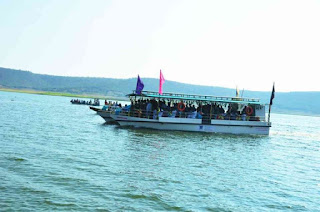Headquarters : Nagarkurnool
Revenue divisions : 3 (Achampet, Kalwakurty and Nagarkurnool)
Mandals : 20
Population : 893,308
Area (km2) : 6,545.00 (2,527.04 sq mi)
Literacy : 53.68%
Highways : NH 167, NH 765, SH 5, SH 18, SH 20, SH 21
Rivers : Krishna, Dindi
Vehicle Registration : TS-31
 Nagarkurnool district is one of the 33 districts in the state of Telangana. Nagarkurnool was carved out
Nagarkurnool district is one of the 33 districts in the state of Telangana. Nagarkurnool was carved out
of Mahabubnagar district and was made as a district on October 11, 2016.
Read More
Revenue divisions : 3 (Achampet, Kalwakurty and Nagarkurnool)
Mandals : 20
Population : 893,308
Area (km2) : 6,545.00 (2,527.04 sq mi)
Literacy : 53.68%
Highways : NH 167, NH 765, SH 5, SH 18, SH 20, SH 21
Rivers : Krishna, Dindi
Vehicle Registration : TS-31
 Nagarkurnool district is one of the 33 districts in the state of Telangana. Nagarkurnool was carved out
Nagarkurnool district is one of the 33 districts in the state of Telangana. Nagarkurnool was carved out of Mahabubnagar district and was made as a district on October 11, 2016.
It is located on the banks of the River Ganges and is famous for its ghats, temples, and spiritual atmosphere. Khajuraho Temples - These temples are a UNESCO World Heritage Site and are known for their intricate carvings that depict scenes from Hindu mythology.
Nagarkurnool was a district 100 years ago. It was a separate district during the period of 1794-1904. After a railway line was built to Mahabubnagar for the sake of easy transportation district headquarters was moved from Nagarkurnool.
Kalwakurthy is the second largest town in Nagarkurnool district with a population of 66,388. There are three revenue divisions under this district. They are Nagarkurnool, Kalwakurthy and Achampet. 85,000 hectares of forest area is under this district. There are 20 mandals and 362 revenue villages in this district. Achampet and Nagarkurnool Assembly constituencies along with parts of Kalwakurthy and Kollapur constituencies come under this district.
Tourism
Nagarkurnool is the district headquarters with a population of 42,000.
Nallamalla forest is located in Nagarkurnool district. Nagarjunasagar-Srisailam Tiger Reserve, which is the largest tiger reserve in India, in spread in this district.
Nallamalla forest is located in Nagarkurnool district. Nagarjunasagar-Srisailam Tiger Reserve, which is the largest tiger reserve in India, in spread in this district.
Kalwakurthy is the second largest town in Nagarkurnool district with a population of 66,388. There are three revenue divisions under this district. They are Nagarkurnool, Kalwakurthy and Achampet. 85,000 hectares of forest area is under this district. There are 20 mandals and 362 revenue villages in this district. Achampet and Nagarkurnool Assembly constituencies along with parts of Kalwakurthy and Kollapur constituencies come under this district.
Tourism
The district is also home to highly popular and truly exotic eco-tourism destination called Somasila, located near Kollapur.
Ecotourism and Adventure Tourism
Farhabad View Point in Nallamala
Somasila Boating
There is a boat trip available in Krishna river from Somasila to Srisailam, which will give tourists a wonderful experience.
Sapthanadula Sangamam (confluence of seven rivers) in Somasila
Nallamalla Forest
There is a boat trip available in Krishna river from Somasila to Srisailam, which will give tourists a wonderful experience.
Sapthanadula Sangamam (confluence of seven rivers) in Somasila
Nallamalla Forest
Religious Tourism
Vattem Venkateshwara Swamy Temple
Mosques
Rangapur Hazrath Niranjan Shah Wali Dargah
Kalwakurthy renamed Mahatma Gandhi LIS Major Irrigation Project located in Regumanigadda of Yellur (V) Kollapur (M) Nagarkurnool district is proposed to provide irrigation water to an extent of 3.40 lakhs acres and drinking water to chronically drought prone upland areas in Mahabubnagar district covering about (303) villages in erstwhile taluks of Kollapur, Nagarkurnool, Achampet, Jadcherla and Kalwakurthy constituencies (in 19 Mandals).
Rajiv Bhima LIS Major Irrigation Project located fore shore of priyadarshini jurala project for Lift-I and foreshore of Ramanpad Reservoir, Ramanpad (V), Atmakur (M), for Lift-II in Wanaparthy District to irrigate 207022 acres in in Makthal, in Mahabubnagar District Atmakur, Wanaparthy in Wanaparthy District and Kollapur Mandal in Nagarkurnool District.
Industries
There is cotton industry in Kalwakurthy.
Irrigation Projects
Kalwakurthy lift irrigation system, Palmuru-Rangareddy lift irrigation system, Srisailam left bank canal tunnel is located in this district.
Completed
Priyadarshini Jurala Major Irrigation Project located near Revulapally village, Dharur Mandal, Jogulamba Gadwal Dist. to irrigate an ayacut of 102,200 acres (41360 Ha.) under Right Main canal DHARUR,GADWAL, ITIKYALA, MANOPAD mandals of Jogulamba gadwal dist and Left Main Canal in drought prone Mandals of ATMAKUR,KOTAKOTA, PEBBAIR,SRIRANGA PUR, WEEPANGANDLA in Wanaparthy district and Pentlavelli, PANGAL in Nagarkurnool district
Under Construction
Alimineti Madhava Reddy Srisailam Left Bank Canal Project (AMRP) was started in 1983 located in Peddavoora(M), Nalgonda District to irrigate 3 lakh acres annd supplying drinking water to the fluoride affected villages enroute.
Proposed
Palamuru Rangareddy Lift Irrigation project is a Major Irrigation Project at Karvena village of Bhoothpur, Mahabubnagar district is approved by government and taken up with an estimated cost of Rs.35,250 crore and seeks to irrigate about 10 lakh acres in Mahabubnagar, Ranga Reddy and Nalgonda districts besides providing water for drinking and industrial needs in and around Hyderabad.
Revenue Divisions : 3
Mandals : 20
Revenue Divisions : 3
- Achampet
- Kalwakurthy
- Nagarkurnool
Mandals : 20
Nagarkurnool Revenu Division Mandals : 9
- Bijinapally
- Nagarkurnool
- Peddakothapal ly
- Telkapally
- Thimmajipet
- Tadoor
- Kollapur
- Pentlavelli
- Kodair
Kalwakurty Revenu Division Mandals : 5
- Kalwakurty
- Urkonda
- Veldanda
- Vangoor
- Charakonda
Achampet Revenu Division Mandals : 6
- Achampet
- Amrabad
- Padara
- Balmoor
- Lingal
- Uppununthalanthala
Source
http://www.gloriousindia.com/g/Telangana/Nagarkurnool

























